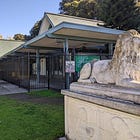How All The Plans Fit Together
In Which: We explain what the 2040 General Plan is for, Council starts wrapping their arms around it, And Councilmember Roche asks the Police Chief a lot of questions about homelessness.
What Even Is The General Plan?
Although the Planning Commission passed on its opportunity to ask questions about the 2040 General Plan, the City Council took a deeper look into how it should be used for actually governing the City. It also revealed a lot about how some Councilmembers think about Housing and Homelessness. But before we get into that, what is the General Plan?
The 2040 General Plan is an enormous document, mandated by the State, that guides the long-term development of the City of Hayward. There’s a lot of information in there, including things on Housing and Homelessness, economic development, community safety, hazards, and environmental justice. The 2014 City Council approved the plan, after a lot of community outreach, and most of it will be in effect until 2040—some bits, like the Housing Element, are updated more frequently. But the Vision, laid out in 2014, largely stays the same.
To be honest, a lot of the Vision sounds pretty good—if sometimes out of the City’s direct control. There’s a lot in there about schools and colleges and parks which are largely determined by other agencies like HUSD, the Chabot-Las Positas Community College District (CLPCCD), CSU East Bay, and HARD. To try to make the vision a reality, there are 433 projects that the City has decided to take on which align with the General Plan. Though 300 of those plans were recently added as parts of the Housing Element and Climate Action Plan, updated in 2023 and 2024 respectively.
The point is that everything the City does should align with the General Plan and the Vision that it lays out until it gets revamped around 2040. If it sounds like a lot, you’re not the only one.
How Do We Even Use This Thing?
Councilmember Roche started the Council comments by admitting that knowing what to do with the General Plan isn’t always obvious, even to the City Council. “I’ve been here for two and a half years,” she said, “and I’m still trying to get my arms around the General Plan.”
Councilmember Bonilla then asked the obvious question: How do the General Plan and the Strategic Roadmap work together? Staff said that General Plan is a 20-year document and the Strategic Roadmap changes annually, so the Strategic Roadmap goals are immediate plans and Staff generally tries to fit those plans into the General Plan vision. “For the most part,” they said, “what we’re trying to do is stich them together.”
He then asked how to align the Strategic Roadmap with the long-range plans of the General Plan. Staff said, “Strategic priorities are most beneficial when they align with the General Plan programs because you’re achieving an overall goal.” But Councilmember Bonilla noted that many of the General Plan programs don’t align with the Strategic Plan. “I would be under the impression that all of the work we should be doing should be aligned to the Strategic Roadmap,” he said, “or we should be questioning why we’re doing it.”
Staff noted that although the General Plan programs don’t all align with the Strategic Roadmap, that’s because it’s supposed to work the other way around. “There are programs in here that align with every single Strategic Roadmap initiative,” Staff said.
Councilmember Syrop was also looking for clarity. “We saw a lot of confusion tonight about the relationship between the Strategic Roadmap and the General Plan. I think clarifying that would be really helpful.” But after Staff’s explanations, he had a better grip on things. “It’s really the Strategic Roadmap that determines which projects from the General Plan or closely aligned projects from the Plan get plucked out and worked on first.”
How Do We Make Changes?
Some on Council were worried that some of the projects that were relevant in 2014 aren’t really relevant over a decade later. “I see a lot of these projects in here and I’m just wondering how relevant they still are today,” Councilmember Bonilla said. “Especially if I see a project that was supposed to start in 2014 and finish in 2016 and it hasn’t started yet. Is it still relevant? Do we still need to do it? Should we still be focused on it?”
“I also felt similarly,” Councilmember Syrop said. “How do we know we still want some of these projects? Are they relevant?” He highlighted just how much has happened in the last decade. “I think I was about to graduate college when this was first put out by the City,” he said, “and that was a very different time… I think we learned a lot as a City—as a society since then, I hope.”
With those questions in mind, he asked if there was a way to do more regular updates to the General Plan. At the time it was approved, the City Council was made up of then-Mayor Michael Sweeney and Councilmembers Mark Salinas, Marvin Piexoto, Al Mendall, Barbara Halliday, Francisco Zermeño, and Greg Jones. Sara Lamnin and Elisa Márquez were still on the Planning Commission and, as he noted during his brief comments, Daniel Goldstein was just a resident on the General Plan Update Task Force. It’s fair to say that a lot has happened since then.
“I want to make sure there is room for effective Council input, too,” Councilmember Syrop said. “If I had an idea of something I wanted to change or multiple programs I disagreed with, I don’t think tonight would be the appropriate night to do that. I want to be intentional with how we revisit this General Plan.”
Unfortunately for the City Council, updating the General Plan is a really big undertaking. “If the Council is interested in amending the General Plan and amending the implementation programs,” Staff said, “that would require a significant amount of outreach to the community, not just the Council, prior to it going through the Planning Commission and other Commissions and Committees and back to Council and that would be a significant work effort.” But if they wanted that, Staff recommended adding it to the Strategic Roadmap. “Because that’s where you’re directing City Staff.”
Councilmember Andrews also wanted to tie the General Plan to the Strategic Roadmap more closely during their discussions. “I would like to have this lens when we do have the roadmap discussion,” she said, “just because we kind of do it in a silo.”
Homelessness And Public Safety
Councilmember Roche asked questions about the role of the Police Department with HPD now that School Resource Officers (SROs) have been removed from school sites. “What does that mean for the goal under the General Plan for school safety?” Police Chief Matthews reassured the Council that HPD still has a presence in schools, for better or worse.
“Although the SRO program is not currently in existence,” Chief Matthews said, “there is continued collaboration with HUSD on safety issues.” He said that there is a Sergeant acting as a liaison with HUSD and they review all school safety plans. HPD also receives frequent calls from school sites directly. “A conversation regarding that may be worth it depending on what happens with the SRO program.”
Councilmember Roche then said she wanted to ask the Chief a question about housing, but revealed it was about Fentanyl. “It just seems like anecdotally like there’s more people that don’t want to accept shelter because it is so intense. How do you see that changing?” The Police Chief, who is not in the Community Services Department, admitted that it isn’t just an issue with unhoused people. “I don’t know that it’s specific to the unhoused community,” he said, “although we do see cases there.”
Councilmember Roche continued to ask Chief Matthews questions about how best to address homelessness, referring to a stubborn myth that there are people who simply wish to remain unhoused. “I do think there’s a difference between people that are generally unhoused and would like shelter,” she said, “and the other people that don’t want that and they want to sort of continue to live on the streets where they’re living. So how do we decipher those two?”
The Police Chief admitted that homelessness is more complicated than that. “It’s really hard to come up with a single strategy that applies to everybody because everybody’s needs are different.” Both Community Services Staff and Service Providers have listed the many difficulties and barriers that people face around shelters, and that’s when a bed is even available.
Councilmember Andrews asked about crime prevention by design. Staff said that all developments submit plans for Crime Prevention Through Environmental Design (CPTED) to the Police Department, and recommendations are usually incorporated. Councilmember Andrews then asked about City properties specifically. “I don’t know if there’s anything we can do to help get some kind of contributions as part of impact fees that help with City property and lighting,” she said. Staff admitted that there wasn’t an adopted plan for that.
Later Councilmember Andrews said that she felt Economic Development was a key part of making people safe. “[Economic development work] I see is in partnership with Public Safety. I think Economic development is public safety, it is crime prevention, and hopefully there’s some goals there that we can overlap with there.” The idea that improving economic conditions of residents prevents crime isn’t a new one, though it runs the risk of succeeding by displacing longtime residents.






